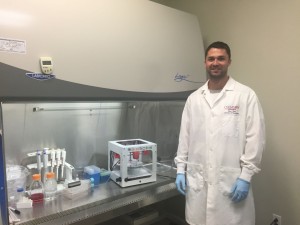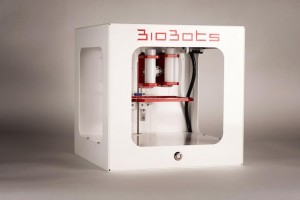Timothy Olsen, TCNJ Class of 2012 alumnus, is changing the world. The way he’s doing it – developing 3D bioprinting.
Bioprinting is a process that focuses on identifying critical structural and compositional elements of human cells or tissue that can be replicated through an intricate designing tool, a bioprinter, which is used in a laboratory atmosphere.
“Think about your desktop printer you have at home. Instead of a printer that prints with black ink, it prints in 3D,” Olsen explained. “The cartridge has cell and materials that your body is used to and likes. It’s a combination of cells and bio materials.”
Directing daily lab operations at BioBots, a bioengineering company producing and innovating bioprinting technology, Olsen works on a team of Bio Ink engineers that create the tissue needed for production and assimilation.
The company’s BioBot 1 is a 3D bioprinter that constructs “3D living tissues out of human cells,” according to the organization’s webpage. “We’re accelerating the pace of regenerative medicine,” Olsen said about BioBots.

After earning a bachelor’s in biomedical engineering from TCNJ, Olsen earned his masters and PhD in bioengineering at Clemson University in South Carolina.
For Olsen, pursuing a career in bioengineering wasn’t always the obvious choice. At first a biology major, Olsen made the switch to engineering before his freshman year began, but didn’t know what field of engineering interested him the most – that is, until a special CBS “60 Minutes” aired.
“I was watching a ‘60 Minutes’ where soldiers were coming back from the battlefield with damaged organs and limbs,” Olsen explained. “They were figuring out ways to regenerate them [organs]. I knew then I was in the right department.”
Olsen continued his fascination with bioengineering throughout his Senior Project. He worked on a team of four developing tissue fabrication. The project’s goal was to make material that contains cells and help prepare and regenerate different tissues in the body.
“The Senior Project really exposed me to the design process,” Olsen said. “Learning to review content in scientific papers… guided me in the direction to pursue graduate school research.”
Olsen and his team worked with Dr. Karen Chang Yan, Associate Professor of Mechanical and Biomedical Engineering. “I was kind of lucky because Yan earned her PhD at Drexel and Clemson, which is where I ended up going,” Olsen said. Yan told Olsen that the forefront of bioengineering was happening at Clemson University, which led to Olsen’s decision to attend graduate school there.
“It [Senior Project] took so much time, but it was so much fun,” Olsen explained. “There were a lot of long nights, a lot of good friendships, good networking opportunities… it was really exciting for me.”
Gaining basic research experience from his senior project, Olsen regrets not getting involved in more research opportunities as an undergraduate. He advises students to get involved in research to gain valuable experience that’ll apply to their future careers.
“I think that there’s a ton of opportunities out there that people don’t take advantage of,” Olsen noted. “The earlier you get involved the better because it helps you stand out. It give you more experience when you want to apply to [graduate] schools.”
According to Olsen, participating in research projects not only allows students to stand out as a potential graduate school or employee candidate, but it also allow students to discover what type of research they enjoy conducting.
“Research projects guides your interests and passions,” Olsen added. “If you want to go into a field of science, you need research experience.”
Research is a consistent factor in engineering – especially in the up-and-coming world of 3D printing, which is still under 20 years old, according to Olsen. Since the arena of regenerative medicine is relatively recent, there are always new developing technologies that produce breakthroughs in research and application. “There’s room to grow,” Olsen said. “With more advanced and more technology developed, [regenerative medicine] is growing very quickly.”

This field of bioengineering is particularly important to Olsen because the main objective is to translate therapeutic solutions of lost tissue and organs that affect real patients who are suffering.
“This technology developed is giving new options and therapies to patients who didn’t really have any hope before that,” Olsen said. “That’s what drew me – that’s what exciting for me.”
Olsen encourages students to look into the world of 3D bioprinting. He also looks forward to the new research and laboratory opportunities that will be available to students through the STEM renovations that are soon coming to TCNJ’s campus.
Whether students pursue their engineering interests in the emerging fields of bioengineering, or electrical, mechanical, civil, or computer – hard work “forever pays” and “there is a light at the end of the tunnel,” reassured Olsen. “This is true at any level – undergraduate, intern, or professional… if you put in effort, you’re going to be first in line. Personally, I know it’s not easy to get through an engineering career – keep working and it will pay off.”
